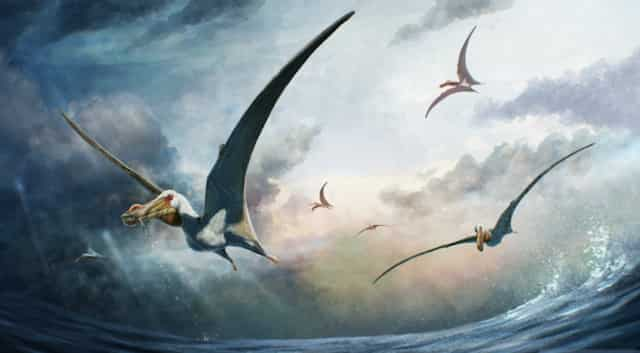Paleontologists have uncovered a new species of pterosaur from fossilized bones dated to be 100 million years old in western Queensland, Australia. This flying reptile coexisted with dinosaurs during its time.
Research Publication
The discovery is detailed in the study titled “Haliskia peterseni, a new anhanguerian pterosaur from the late Early Cretaceous of Australia,” published in Scientific Reports. The research was led by Curtin University.
Fossil Discovery
The fossilized remains were unearthed in 2021 by Kevin Petersen, a curator at the Kronosaurus Korner Museum in Richmond, Australia. The remains have been classified as Haliskia peterseni, a new genus and species of anhanguerian pterosaur.
Background on Pterosaurs
Pterosaurs were a group of flying reptiles that existed from the Late Triassic to the end of the Cretaceous period. They varied greatly in size and adaptations, from small bird-like creatures to large predators with immense wingspans. Notable pterosaurs like Quetzalcoatlus, the largest known flying animal, have been featured in movies such as Jurassic Park.
Identification and Analysis
PhD student Adele Pentland from Curtin’s School of Earth and Planetary Sciences led the research team that identified the specimen as an anhanguerian pterosaur. The identification was based on the analysis of the skull shape, tooth arrangement, and shoulder bone structure. Anhanguerian pterosaurs were known to have existed worldwide, including regions like Brazil, England, Morocco, China, Spain, and the United States.
Characteristics of Haliskia peterseni
Pentland described Haliskia peterseni as a fearsome predator with a wingspan of approximately 4.6 meters. Around 100 million years ago, much of central western Queensland was covered by a vast inland sea, situated globally near where Victoria’s southern coastline is today.
Significance of the Discovery
The remains, meticulously prepared by Mr. Petersen, represent the most complete specimen of an anhanguerian and any pterosaur discovered in Australia to date. Haliskia peterseni is 22 percent complete, significantly more than the only other known partial pterosaur skeleton found in Australia.
Details of the Specimen
The specimen includes:
- Complete lower jaws
- Tip of the upper jaw
- 43 teeth
- Vertebrae
- Ribs
- Bones from both wings
- Part of a leg
- Very thin and delicate throat bones, suggesting a muscular tongue for feeding on fish and cephalopods.
Multiple Choice Questions (MCQs):
- Where were the fossilized remains of the new pterosaur species discovered?
- A. Brazil
- B. England
- C. Western Queensland, Australia
- D. Morocco
- What is the title of the study that details the discovery of the new pterosaur species?
- A. “The Largest Flying Reptile”
- B. “Haliskia peterseni, a new anhanguerian pterosaur from the late Early Cretaceous of Australia”
- C. “Dinosaurs of the Cretaceous Period”
- D. “Flying Reptiles of Australia”
- Who led the team that identified the specimen as an anhanguerian pterosaur?
- A. Kevin Petersen
- B. Adele Pentland
- C. Richard Owen
- D. Curtin University
- Which of the following features were analyzed to identify Haliskia peterseni as an anhanguerian pterosaur?
- A. Skull shape
- B. Tooth arrangement
- C. Shoulder bone shape
- D. All of the above
- How complete is the specimen of Haliskia peterseni compared to other known pterosaur skeletons found in Australia?
- A. 10 percent complete
- B. 22 percent complete
- C. 50 percent complete
- D. 75 percent complete
